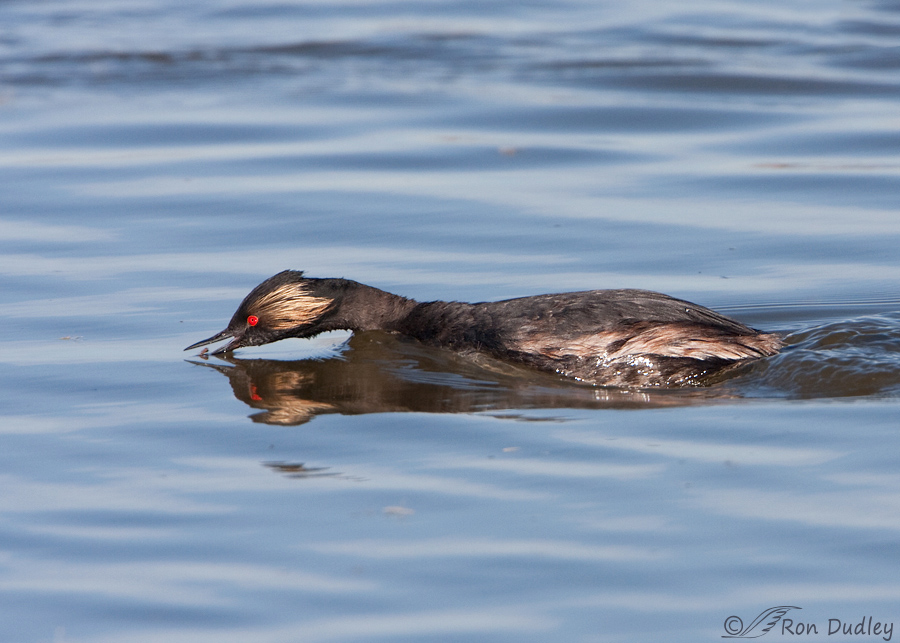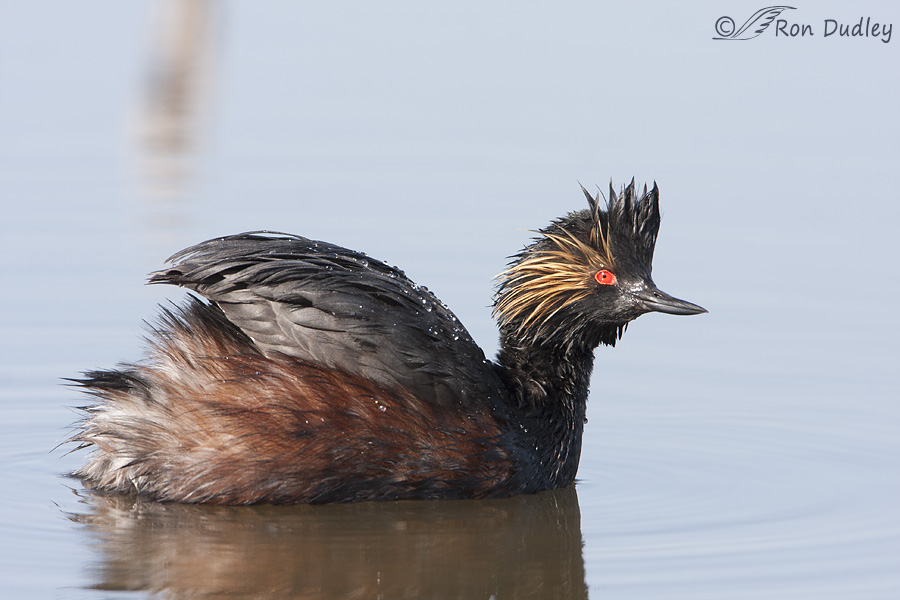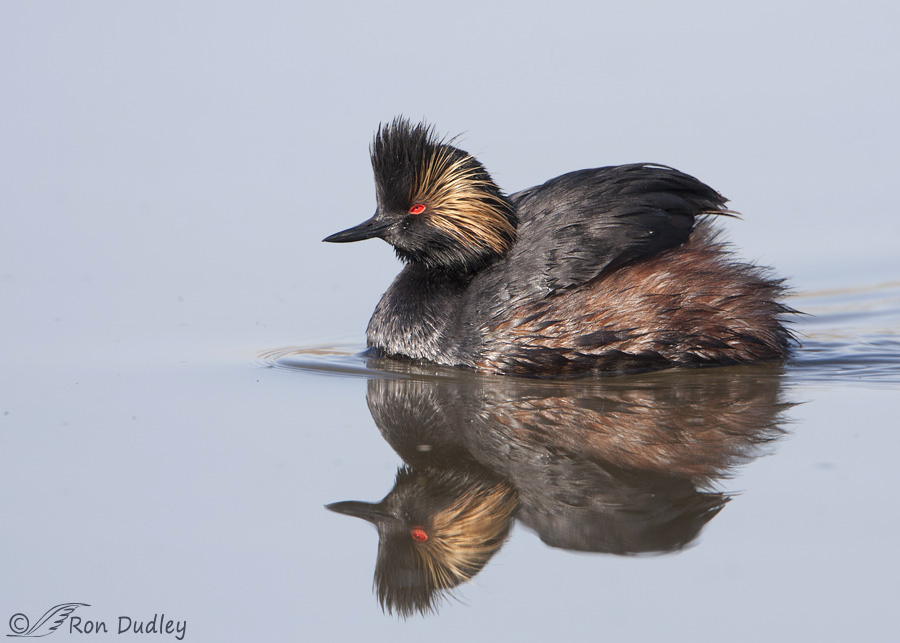Occasionally I like to post older images and these Eared Grebe photos go back almost to the beginning of my bird photography “career”.
Eared Grebes are by far the most abundant grebe species on the planet and we have gazillions of them here in northern Utah. Immediately after the breeding season most of the entire North American population moves to the Great Salt Lake (or to Mono Lake in California) to take advantage of the superabundant brine shrimp and brine flies in those locations but I’ve always had difficulty getting close to them.

1/1600, f/8, ISO 400, Canon 40D, Canon EF 500mm f/4L IS USM + 1.4 tc, not baited, set up or called in
But way back in April of 2008 (I was still learning how to use my relatively new 500mm lens) there was an insect hatch on the surface of Glover Pond (near Farmington Bay) and I was able to spend a couple of mornings with some of the grebes as they skittered across the water chasing “bugs”. Most of the floating insects were close to shore so that brought the birds in close to me. It was a great technique-learning experience for me because the grebes were twisting and turning and changing directions as they sped across the water after insects – it was almost like trying to lock and keep focus on birds in flight.
Here one of the grebes is just about to snatch an insect (a mosquito I believe) off the surface of the water.

1/400, f/9, ISO 500, Canon 40D, Canon EF 500mm f/4L IS USM + 1.4 tc, not baited, set up or called in
I think Eared Grebes are pretty spectacular in breeding plumage with their blacks, cinnamon-browns, bright golden ear tufts and scarlet eyes. This bird had been diving for prey and every time it came up it would give me a quick glance before diving again.
In the 8+ years since these images were taken I’ve never been this close to Eared Grebes again – this image is full frame (uncropped).
 1/800, f/7.1, ISO 500, Canon 40D, Canon EF 500mm f/4L IS USM + 1.4 tc, not baited, set up or called in
1/800, f/7.1, ISO 500, Canon 40D, Canon EF 500mm f/4L IS USM + 1.4 tc, not baited, set up or called in
On one of those mornings the water was as smooth as glass and some of the birds were resting after their feeding session so I was able to get some nice shots that included a full reflection. I was shooting from shore with my tripod (rare for me, usually I shoot from my pickup) so I was able to get a low angle which nearly always makes an image more intimate and appealing.
I often see hundreds of thousands (literally) of Eared Grebes out on the Great Salt Lake but most of them are so far away they just look like dots on the water if I can see them at all. Some are close to shore but they move further out if I try to approach. So for me it was a unique experience to be allowed this close to these colorful little grebes.
Ron


The grebe after the mosquito reminds me of a Chinese dragon. I like the second photo because it really shows off their fluffy rump.
I guess you didn’t know how lucky you were to be that close with your new lens.
I think I did know how lucky I was, Pam. I remember having a touch of buck fever over the excitement. Had to settle down a little so I could concentrate on what I was trying to do. Thankfully the birds gave me time to do that.
Awesome Shot.
Thank you for posting them. I love the second one…
Oh my gosh!!!!!!!!!!!!!!! Never had the pleasure of seeing one!!!! Incredible pictures!!!!!! You keep me going Ron!!
“You keep me going Ron!!”
Ha, that’s a new thing to say on my blog, Marina. Loved it!
Stunning. How lucky (and diligent) you are.
Thanks, EC.
Like water, the crisp, sharp reflection , the dark browns set off by bright golds and thise wonderful, ruby-red eyes! At first glance almost drab, at second, spectacular….
Thank you, Patty.
Beautiful photos, there ear tufts glow a radiant gold in the sun it is so striking with the red eye and dark blacks. Thank you for re-posting. I have had a few Eared grebes in my tub! I am always surprised at how small they are when in hand. There are 2 birds that I just love how they feel when I hold them. One is Eared Grebes and the other Ruddy Ducks. They have these small fat round bodies that for some reason just have a pleasing feel as you hold them. The grebes have giant feet so far back on their body they can’t walk on land which is usually why we get them to rehab. They have landed on land instead of water and can’t get airborne again. People pick them up and bring them to us.
April, I remember a few years ago when an entire flock of them landed on the ground in a storm out by Tooele and many of them had to be rescued. I think that happens to them fairly often.
Unfortunately it happens often, they mistake parking lots for water and land on them. They get their feet legs and wings (wrists) badly abraded scooting around trying to get airborne again.
Terrific series, Ron!! Like Susan, I’ve never seen an Eared Grebe so I’m glad you decided to share these with us – even though you took them WAY back in 2008 – LOL!! I love all three captures for different reasons but I’d have to say the second one is my favorite. I like the look of all those wet feathers, the gold ear tufts and the best is the evil Red Eye it’s giving you!! There is something special about having one of our wild birds to acknowledge our presents even when it’s not happy about it!! I also have to say that I seem to do the same thing with our white Ibis that I can see in high numbers in my own yard that I need to remind myself not to take this gorgeous bird for granted!!
It can be easy to take a common species for granted, Jo Ann – a mistake I try to avoid but I’m not always successful.
WOW! Another first for me! What a gloriously beautiful bird! I love the first and last shots the best–but they’re all spectacular.
Thank you so much for sharing!
They’re not common back east, Laura. Maybe you’ll see them after your move out west. Hope so.
Beautiful! Picture perfect reflection is amazing! The coloring is wonderful.
Thank you, Judy.
Another bird I’ve never had the pleasure of meeting. I love these shots, especially the last one. The detail on the reflection is amazing. Glad you got to spend quality time with these beautiful birds.
The last image is my favorite too, Susan, though I do enjoy the behavior in the first one.
Great shots Ron!
Charlotte Norton
Thanks, Charlotte.
Loooove the last image… It’s like the bird is floating on a mirror. More great shots,
and yes, the low angle adds to the impact of the shot. Yes it does pay to exit
the “iron horse” once in awhile, when situations permit. ;-)))
Thank you, Roger. The relatively high angle I often get when shooting birds on the water is one of the few disadvantages of shooting from my pickup. But since being on foot tends to scare the birds off I’d rather get the high angle shot than no photo at all…